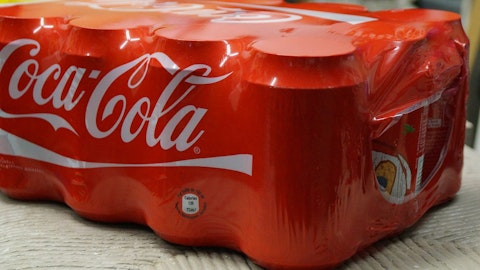Illinois Tool Works Inc. (NYSE:ITW) Q4 2022 Earnings Call Transcript February 2, 2023
Operator: Good morning. My name is Cheryl, and I will be your conference operator today. At this time, I would like to welcome everyone to the ITW Fourth Quarter Earnings Conference Call. Karen Fletcher, Vice President of Investor Relations. You may begin your conference.
Karen Fletcher: Thank you, Cheryl. Good morning, and welcome to ITW’s Fourth Quarter 2022 Conference Call. I’m joined by our Chairman and CEO, Scott Santi; and Senior Vice President and CFO, Michael Larsen. During today’s call, we will discuss ITW’s fourth quarter and full year 2022 financial results and provide guidance for full year 2023. Slide 2 is a reminder that this presentation contains forward-looking statements. We refer you to the company’s 2021 Form 10-K and subsequent reports filed with the SEC for more detail about important risks that could cause actual results to differ materially from our expectations. This presentation uses certain non-GAAP measures, and a reconciliation of those measures to the most directly comparable GAAP measures is contained in the press release. Please turn to Slide 3, and it’s now my pleasure to turn the call over to our Chairman and CEO, Scott Santi.
Scott Santi: Thanks, Karen, and good morning, everyone. As you saw from our release this morning, in Q4, we delivered a strong finish to a year of high-quality execution in the face of some pretty unique challenges in the operating environment. Starting with the top line organic growth, was 12% as all segments delivered positive organic growth, and five of our seven segments grew double digits, led by Auto OEM, up 20%, Food Equipment, up 17%, Welding, up 15%, Polymers & Fluids, up 11% and Test & Measurement and Electronics, up 10%. Construction Products was up 4%, and Specialty Products was up 3%. Operating margin expanded 210 basis points to 24.8%, with 110 basis point contribution from enterprise initiatives and favorable price/cost margin impact of 70 basis points, which was for the first time in nine quarters — which was favorable for the first time in nine quarters.
Incremental margin was 52%, and operating income grew 18%. GAAP earnings per share increased 53% to a record $2.95, including $0.61 of gains from divestitures and $0.12 of negative currency — excluding $0.61, sorry, of divestiture gains and $0.12 of negative currency EPS growth was 27%. For all of 2022, the company delivered organic growth of 12% for the second year in a row, best-in-class operating margin of 24.4% in our base business, after-tax return on invested capital of 29.1% and record GAAP EPS of $9.77, an increase of 15% versus the prior year. There’s no question that our decision to stay invested in our enterprise strategy and then our people throughout the pandemic and the quality of our team’s execution of our when the recovery focus coming out of it are powering the strong growth and financial performance, ITW is currently delivering.
As a result, we are very pleased with our momentum and positioning heading into 2023. Turning to our 2023 guidance. Demand remained solid across the majority of our portfolio, and we are seeing meaningful improvements in supply chain performance and moderating input cost inflation. At the same time, there’s no question that the economic outlook, let’s call it, remains certainly dynamic. As a result, our organic growth projection for 2023 of 3% to 5% and our EPS guidance of $9.60 at the midpoint reflect current levels of demand and a risk adjustment for further slowing in certain end markets. And Michael will provide more detail on that in just a minute. Before I turn it over to Michael, I want to again thank my ITW colleagues around the world for their extraordinary dedication and commitment to serving our customers and executing our strategy with excellence.
Michael, over to you.
Michael Larsen: Thank you, Scott, and good morning, everyone. The demand growth that we’ve experienced all year continued into the fourth quarter as revenue grew 8% with organic growth of 12%. On an equal day’s basis, organic growth was 14% as the fourth quarter this year had one less shipping day compared to prior year. We finished the year with strong growth momentum as evidenced by our sequential organic revenue growth of plus 4% from Q3 into Q4 on a sales per day basis as compared to our historical sequential of plus 2%. By geography, every major region grew double digit, with North America up 13%, Europe up 11% and China up 10%. Foreign currency translation headwind reduced revenue by 5%, and the net impact from acquisitions and divestitures was plus 1%.
GAAP EPS grew 53% to $2.95 and included a $0.61 gain from two divestitures, which I’ll provide more detail on in a moment. Excluding those gains, EPS increased 21% to $2.34, which included $0.12 of EPS headwind from foreign currency translation. So, on an apples-to-apples basis, eliminating both divestiture gains and currency headwind, EPS increased 27%. On the bottom line, operating income grew 18%, with strong incremental margin performance of 52% and operating margin improved 210 basis points to 24.8%. Operating margin in our base businesses, excluding MTS, was 25.2%. In the fourth quarter, we achieved favorable price/cost margin impact of 70 basis points. And as Scott said, this was the first quarter with favorable margin impact from price/cost since the third quarter of 2020.
Enterprise Initiatives contributed 110 basis points. As you saw in the press release, we completed two divestitures in the fourth quarter, resulting in a combined pretax gain on sale of $197 million recorded in nonoperating income and an EPS impact of $0.61. By utilizing capital loss carryforwards to offset taxes on the divestiture gains, the overall tax rate for the company was 19.1%. So overall, for Q4, excellent operational execution across the board, strong financial performance and what remains a pretty uncertain and volatile environment. Okay. Please turn to Slide 4, starting with our progress on organic growth. And as you know, we’ve been aggressively executing a very focused growth strategy to build consistent above-market organic growth into a core ITW strength on par with our operational 80/20 front-to-back capabilities.
As you can see from the data on the left side of the slide, ITW’s 12% organic growth rate for each of the last two years compares favorably to our proxy peers at about 9% both years, suggesting that while we’re not there yet in terms of realizing ITW’s full potential organic growth performance, we’re making some very solid progress. Moving on to the segment results, starting with Automotive OEM, which led the way with organic growth of 20%. Year-on-year revenue growth was, of course, helped by supply chain challenges in the industry last year. North America was up 15% and Europe grew 23%. China was up 17% with particularly strong growth in electric vehicles. On a full year basis, ITW Automotive OEM revenues were up 12% versus 6% growth in car builds.
Looking forward, we expect Automotive OEM to grow 5% to 7% in 2023 based on a risk-adjusted auto build assumption in the low single digits plus our typical penetration gains of 2% to 3%. Turning to Slide 5. Food Equipment delivered another very strong quarter with organic growth of 17%. North America grew 25% with double-digit growth in all major categories and end markets. Institutional was up more than 40% with strength across the board, restaurants were up 30% and retail grew 20%. International revenue grew 7%, with Europe up 9% and Asia Pacific was flat with some near-term softness in China. The Food Equipment team also delivered excellent progress on margins, with Q4 operating margin of 27.6%, an increase of almost 500 basis points year-over-year.
So obviously, strong momentum in this segment, and we expect Food Equipment to grow 8% to 10% in 2023. Test & Measurement and Electronics revenue grew 15%, with organic growth of 10%. Test & Measurement grew 12% organic, excluding the acquisition of MTS, with continued strong demand for capital equipment as evidenced by Instron, which grew 24%. Electronics was up 7%. While our semi-related businesses, which represent combined annual revenues of about $550 million or approximately 20% of the segment, grew 17% in the quarter. We are beginning to see a slowdown in demand after three years of very strong growth. So, embedded in our 2023 organic growth projection of 2% to 4% for this segment is anticipated further slowing in semi-related end markets.
Moving on to Slide 6. Welding delivered strong organic growth of 15% in Q4, with equipment up 17% and consumables up 13%. Industrial sales remained very strong with organic growth of 25%. On the commercial side, which is more consumer-oriented, demand continued to slow and organic growth was down 1%. On a geographic basis, North America grew 15%, and international grew 17%, driven by strength in the oil and gas business, up 19%. Operating margin was up 160 basis points to 31.6%, a new record for the segment and for the company. Looking forward, we expect revenue to grow 5% to 7% in 2023, which includes some anticipated further slowing on the commercial Welding side. Polymers & Fluids delivered organic growth of 11%, with the automotive aftermarket business up 13% with some seasonal strength in wiper blades.
Polymers grew 11% with continued strength in industrial applications, and Fluids was up 5%. North America grew 11% and international was up 10%. Looking forward, we expect Polymers & Fluids to grow 3% to 5% in 2023, which is based on current levels of demand and anticipated further slowing in the more consumer-oriented automotive aftermarket business. Turning to Slide 7. Overall demand in Construction slowed to an organic growth rate of plus 4%. North America was still up 9%, with residential up 11% and commercial construction was down 6% due to a tough comparison of plus 21% last year. Europe was up 3% and Australia and New Zealand was down 4%. As you know, Construction is our most interest rate sensitive segment, and we are projecting further slowing in 2023 and a negative organic growth rate of minus 5% to minus 3%.

Photo by ThisisEngineering RAEng on Unsplash
Specialty organic growth was 3% as supply chain shortages eased up in Q4, and the equipment businesses had a strong finish to the year with organic growth of 8%. Consumables were up 2%. And on a geographic basis, North America grew 1% and international grew 7%. Looking forward, we expect Specialty organic revenue of negative 1% to plus 1% in 2023, which is based on current levels of demand and anticipated further slowing in the appliance components business. So, let’s turn to Slide 8 for a recap of a very strong 2022. As throughout the year, our teams around the world did an exceptional job of delivering for our customers, while responding quickly and decisively to rapidly rising input costs, navigating supply chain disruptions and aggressively executing our Win the Recovery strategy.
As a result, for the full year, ITW grew organic revenue by 12% with double-digit growth in five of seven segments. And despite significant price/cost margin pressures and thanks in part to 90 basis points contribution from our enterprise initiatives, our base businesses expanded operating margin by 30 basis points to 24.4%. GAAP EPS of $9.77 was a record for ITW with EPS growth of 15% on top of 28% EPS growth in 2021. Excluding divestiture gains and negative currency translation impact, EPS grew 12% in 2022 on an apples-to-apples basis. In 2022, we also invested more than $700 million to accelerate organic growth and to sustain productivity in our highly profitable core businesses. Raised our dividend 7%, marking the 59th year of consecutive increases.
Returned $3.3 billion to shareholders in the form of dividends and share repurchases and made solid progress on the integration of a very high-quality acquisition in the MTS Test and Simulation business. And most importantly, we delivered these results while continuing to make meaningful progress on our path to ITW’s full potential through the execution of our long-term enterprise strategy. So, let’s move to Slide 9 for an update on our full year 2023 guidance. And while we certainly see some positives in terms of supply chain easing and moderating input cost inflation, there’s also no doubt that the economic outlook and demand picture is becoming increasingly uncertain. On our last Q3 earnings call, we pointed to pockets of slowing demand at approximately 20% of our business portfolio.
And today, we would add semiconductor-related end markets to the mix bringing the total to about 25% of ITW’s portfolio. In our view, it therefore made sense to take a more cautious approach to our top line guidance this year by basing it not just on current levels of demand, adjusted for seasonality as we typically do, but rather anticipating further slowing in end markets related to construction, commercial welding, auto aftermarket, appliances and semiconductor. As a result, our organic growth rate projection for 2023 of 3% to 5% is lower than our typical run rate approach. Operating margin is expected to improve by 100 basis points or more to a range of 24.5% to 25.5%. This includes approximately 100 basis points contribution from enterprise initiatives and positive price/cost margin impact based on all known and implemented price and cost actions.
After tax return on invested capital should improve to 30% plus, and we expect strong free cash flow with conversion greater than net income. For 2023, we expect GAAP EPS in the range of $9.40 to $9.80, which also includes $0.15 to $0.20 of higher interest expense on our short-term debt and $0.25 of increased income tax expense as our tax rate will revert to our normal, approximately 24% versus 22% in 2022, excluding the tax impacts from our divestitures. In terms of cadence for the year, we’re now back to our typical first half, second half EPS split of 49% and 51%. Our capital allocation plans for 2023 are consistent with our long-standing disciplined capital allocation framework. Our top priority remains internal investments to support our organic growth initiatives and sustain our highly profitable core businesses.
The second priority is an attractive dividend that grows in line with earnings over time, which remains a critical component of ITW’s total shareholder return model. Third, selective high-quality acquisitions, such as MTS, that enhance ITW’s long-term profitable growth potential and have significant margin improvement potential from the implication of our proprietary 80/20 front-to-back methodology and can generate acceptable risk-adjusted returns on our shareholders’ capital. And finally, surplus capital will be allocated to an active share repurchase program, and we expect to buy back approximately $1.5 billion of our own shares in 2023. Turning to our last slide, Slide 10, for our 2023 organic growth projections by segment. And you can see that we’re expecting solid to mid — solid mid- to high single-digit organic growth in four of our seven segments, offsetting some lower growth rates in Test & Measurement and Electronics, which is due to semiconductor demand, as well as in Construction and Specialty resulting in an overall organic growth rate at the enterprise level of 3% to 5%, which is on top of 12% organic growth in each of the last two years.
Overall, we’re heading into 2023 with strong momentum, and we’re very well positioned to continue to outperform in whatever economic conditions emerge as we move through 2023. And so, with that, Karen, I’ll turn it back to you.
Karen Fletcher: Okay. Thank you, Michael. Cheryl, please open up the lines for questions.
See also 22 Largest Hunting Companies in the US and 10 Best Healthcare Stocks for the Long Term.
Q&A Session
Follow Illinois Tool Works Inc (NYSE:ITW)
Follow Illinois Tool Works Inc (NYSE:ITW)
Operator: Your first question is from Jamie Cook of Credit Suisse. Your line is open.
Jamie Cook: Hi, good morning. Congrats on a nice quarter. I guess, my first question, you talked about the 25% of your portfolio where you’re starting to see weakness. Can you talk — I know semis be incremental. Can you just give a little more color on what you’re seeing in semi? And then on the 75% rest of your portfolio are trends in line with your expectations, a little more positive or negative versus last quarter? And then I guess, just my follow-up question to that price/cost in the quarter, I think it was 70 bps positive. I think that’s a little better than what you expected. Was that driven more by price or raw going down? And then what are your assumptions on the ability to hold price in 2023? Thank you.
Michael Larsen: Okay. That was a lot there, Jamie. I’ll do my best, okay? So, I think the color on semi is really the — we’re coming off a three year very strong growth cycle with growth in the high teens or better than that over those three years. And we are starting to see a slowdown in the order intake really in Q4. So, it hasn’t really showed up in our numbers in a meaningful way yet, but we do expect that to continue into 2023. We think it’s more of a near-term slowdown. And like you said, that is the addition to the portfolio we’ve said before, 20% is slowing. Demand is slowing now. It’s 25%, and semi is really the incremental 5% this quarter. But it’s important to keep in mind that the balance, the other 75% of the portfolio, continues to perform at a really high level.
And I’ll just point to the 12% organic we put up in Q4 and for the full year. And then if you look at our guidance on Slide 10, by segment, you can see mid- to high single-digit growth in Automotive OEM, Food Equipment, Welding, mid-single digit in Polymers & Fluids and then a little bit lower in Test & Measurement. And then of course, Construction is the one that’s a little bit projected to be down year-over-year and Specialty about flat. I’ll also say, if you just look at from Q3 to Q4, we — typically, our sales per day go up 2%, we actually went up 4%. So, we’re more than offsetting some of the slowing that we’re seeing in 25% of the portfolio. So good momentum, really well positioned going into next year. I think on the price/cost side, we were really encouraged.
We talked about this on the last call and an expectation of being positive — slightly positive on margins on price/cost in Q4. This was a little bit better, driven by both sides of the equation really price and cost, but it was certainly great to see that turn positive for the first time since I think I said the third quarter 2020. So, first time in eight quarters, so really encouraging heading into 2023.
Operator: Your next question comes from the line of Scott Davis of Melius Research. Your line is open.
Scott Davis: Hey, good morning. Congrats on another strong year in ’22.
Scott Santi: Thank you.
Michael Larsen: Thank you.
Scott Davis: A little bit of a nit, but on the 3% to 5%, 23 top line for growth forecast. Is there any real price in that? Or you anniversary the big price increases that you had in Welding and now you’re kind of more in the kind of neutral-ish to maybe slightly positive versus a bigger number?
Michael Larsen: Well, I think we are certainly lapping some bigger price numbers. There’s no doubt about that. And I think, as you know, we don’t break out price and volume separately for all the reasons we’ve talked about in the past. But there’s both price and volume in the numbers that we’ve laid out for 2023. And the 3% to 5% organic, I’ll just say it’s a risk-adjusted number. If you do a pure run rate, you end up at a higher number. We just thought given the — everything we talked about, it was probably reasonable to take a more cautious approach given the environment.
Scott Davis: Yes. No, it totally makes sense. What about the inflation assumptions in general when you guys think about the ’23 outlook as far as kind of breaking out materials versus labor? And is it fair to assume that labor inflation remains reasonably high, but material inflation is more moderated? Is that a fair assumption in your guide?
Michael Larsen : Yes. I think that’s reasonable. I think certainly materials and components in that order, we are seeing — I wouldn’t say price are coming — costs are coming down in a significant way, and they’re remaining at a fairly elevated level. And then I think on — our labor costs, certainly we’re experiencing the same labor cost inflation as others. But — and so maybe a little bit higher than typical, but nothing really that significant. We’re still expanding margins by 100 basis points or better here in 2023. So hopefully, that answers your question.
Scott Davis : Yes, it does. Thank you. And best of luck this year.
Michael Larsen : Sure. Thank you, Scott.
Operator: Your next question comes from the line of Tami Zakaria of JPMorgan. Your line is open.
Tami Zakaria : Good morning. Congrats on the great results. So I have a couple of quick ones. The first one is how should we think about your EBIT margin progression throughout the year? Is the 25.5% to — 24.5% to 25.5% range going to be fairly consistent in all the quarters?
Michael Larsen : So Tami, like I said, we’re kind of back to our typical cadence here. I think we said first half, 49% of our EPS for the full year; second half, 51%. We really — if you go back unlike time, we’ve been remarkably consistent. Embedded in that is also the fact that Q1 is typically our lowest quarter in terms of revenue, and we’re expecting somewhere in the mid-single-digit type growth. Margins will probably start out a little bit lower, but still 100 basis points of margin improvement on a year-over-year basis. And maybe just to give an additional data point, if you run the same data on Q1 contribution to EPS overall, it’s somewhere around 23% of the full year, and that’s a pretty — the company has become remarkably predictable over the years. And so I think that’s probably a pretty good estimate for how the first quarter might play out.
Tami Zakaria : Got it. That’s fantastic color. Thank you. And I’m just going to ask the question and I hope I get lucky and get a number. But can you share what organic growth is trending quarter-to-date? Any segments trending negative right now?
Michael Larsen : So we just saw the January numbers and everything looks fine. Everything is tracking and really nothing different from what we talked about in the script here. So we’re off to the start that we thought we would have.
Tami Zakaria: Okay, awesome. Thank you.
Operator: Your next question comes from the line of Andy Kaplowitz of Citigroup. Your line is open.





